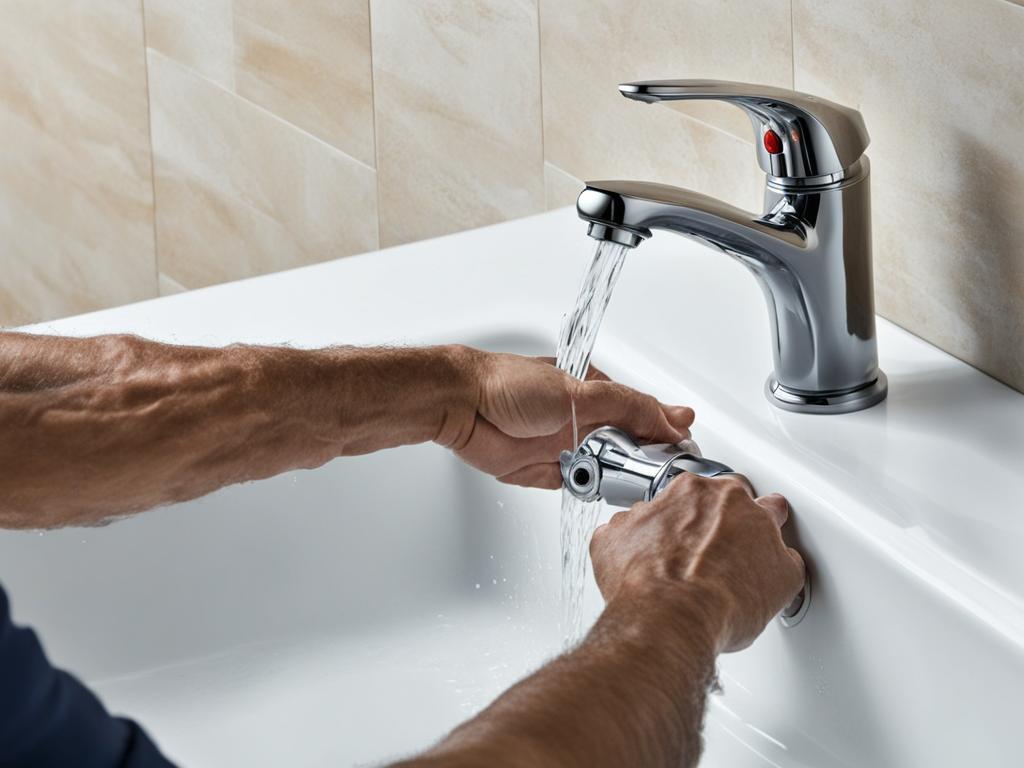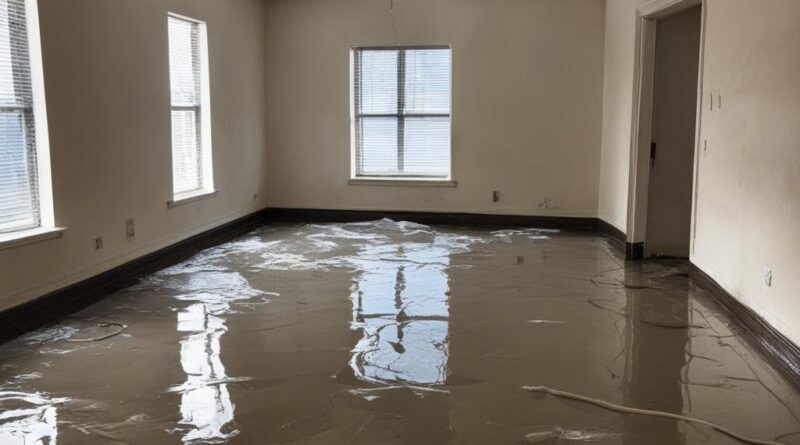Upstairs Neighbor Flooded Your Apartment? Act Now!
Living in an apartment building comes with its fair share of challenges, and dealing with interference from neighbors is one frustrating situation you may encounter. When your upstairs neighbor causes a water-related issue that results in flooding in your apartment, it’s important to know what steps to take. This article will provide essential tips on how to handle this unfortunate situation, including understanding your tenant rights, filing insurance claims, and determining your landlord’s responsibility for the water damage.
Key Takeaways:
- Document the damage by taking pictures and videos, and salvage any belongings that are unharmed.
- Immediately inform your upstairs neighbor, landlord, and insurance provider about the flooding incident.
- Minimize further damage by removing water, using fans and dehumidifiers, and seeking temporary accommodations if necessary.
- Review your renter’s insurance policy to understand the coverage for water damage caused by neighbors.
- Consider seeking professional help from a water damage restoration service to ensure proper cleanup and restoration.
Documenting the Damage and Notifying the Parties Involved
When faced with a flooded apartment caused by your upstairs neighbor, it’s essential to take immediate action to document the damage and notify the relevant parties. Follow these steps to protect your interests and facilitate the resolution process.
Step 1: Document the Damage
Before taking any further action, document the extent of the water damage in your apartment. Use your phone or camera to take clear pictures and videos that capture the affected areas. These visual records will provide crucial evidence for insurance claims and discussions with the involved parties. Be sure to emphasize the most impacted areas and any valuable belongings that have been damaged.
Step 2: Salvage Belongings
While documenting the damage, salvage any belongings that remain undamaged. Move them to a safe and dry location within your apartment or consider temporarily storing them elsewhere if necessary. By salvaging your belongings promptly, you can prevent further loss and facilitate the recovery process.
Step 3: Contact the Neighbor
Take the initiative to contact your upstairs neighbor as soon as possible. Explain the situation calmly and politely, highlighting the impact the flooding has had on your apartment. By maintaining open communication, you can work towards a resolution and potentially prevent future incidents.
Step 4: Contact the Landlord
Inform your landlord about the water damage caused by your upstairs neighbor. Provide them with a detailed account of the incident, including the documented evidence. Your landlord needs to be aware of the situation to assess the necessary repairs and take appropriate action. Open communication will also help establish a record of your proactive steps.
Step 5: Contact the Insurance Provider
To initiate the claims process and seek compensation for the damages, contact your insurance provider promptly. Notify them about the flooding incident, providing all the relevant details and documentation. They will guide you through the claims procedure and assess the coverage applicable to your policy. Be prepared to provide them with any additional information they may require to process your claim efficiently.
Remember, taking prompt action to document the damage and notify the parties involved is crucial in resolving the situation effectively.
Mitigating Further Damage and Seeking Temporary Accommodations
To minimize further damage caused by the flooding, it’s crucial to take immediate action. Start by removing the water from your apartment as soon as possible. You can use towels, buckets, or a wet/dry vacuum to get rid of the excess water. It’s also a good idea to place towels around the affected area to soak up as much water as you can.
Next, you’ll want to utilize fans and dehumidifiers to speed up the drying process and prevent mold growth. Position fans strategically to promote air circulation and dry out the affected areas. A dehumidifier will help remove moisture from the air, reducing the chances of mold and mildew formation.
“By quickly removing water and using fans and dehumidifiers, you can mitigate further damage and prevent additional issues like mold growth.”
If the damage to your apartment is severe and it becomes uninhabitable, it’s essential to seek temporary accommodations. Contact your landlord or property management to discuss the situation and inquire about available options. They may be able to provide you with alternative housing or assist you in finding suitable temporary accommodations.
While seeking temporary accommodations, it’s crucial to stay informed and follow up on the progress of repairs. Regularly communicate with your landlord or property management to ensure that necessary steps are being taken to address the issue and restore your apartment.
Tips for Mitigating Further Damage
| Action | Explanation |
|---|---|
| Remove water | Use towels, buckets, or a wet/dry vacuum to eliminate excess water. |
| Use fans and dehumidifiers | Speed up the drying process and prevent mold growth by utilizing fans and dehumidifiers. |
| Seek temporary accommodations | Contact your landlord or property management to inquire about alternative housing options. |
| Follow up on repairs | Regularly communicate with your landlord to ensure that necessary steps are being taken to address the issue. |
By following these steps, you can mitigate further damage, promote the drying process, and ensure that appropriate measures are taken to repair the water damage caused by your upstairs neighbor. Acting promptly and effectively will help you navigate through this stressful situation and protect your living environment.

Understanding Renter’s Insurance Coverage for Water Damage
When dealing with flood damage caused by your upstairs neighbor, having renter’s insurance can provide a glimmer of hope. However, it is crucial to understand the specifics of your policy to ensure proper coverage. Different types of policies offer varying levels of protection, so it’s essential to review the details.
Most renter’s insurance policies do not cover natural disasters like floods. However, specific water damage perils caused by your neighbor may be covered. For example, if the flood is a result of burst pipes or HVAC system leaks, you may be eligible for coverage.
It is also important to consider the concept of proximate cause. Proximate cause refers to the primary event that led to the water damage. If the proximate cause was an event covered by your policy, such as a burst pipe, then your insurance may cover the resulting water damage.
Understanding the perils covered by your renter’s insurance policy is crucial in determining whether you can claim coverage for water damage caused by your upstairs neighbor. Review your policy carefully and consult with your insurance provider to gain clarity on the coverage you have.
“Knowing the specifics of your renter’s insurance policy regarding water damage coverage can make a significant difference when going through the ordeal of a flooded apartment caused by your upstairs neighbor. Being informed and prepared will help you navigate the claims process more effectively.”
Conclusion
Dealing with a flooded apartment caused by your upstairs neighbor can be a frustrating situation. However, it is crucial to take immediate action to minimize damage and restore your home. One of the best steps you can take is to seek professional help from a trusted flood damage restoration service. These professionals have the expertise and equipment to effectively clean up and restore your apartment, ensuring that any water damage is thoroughly addressed and mitigated.
Resolving neighbor disputes is also important in this situation. Open communication and a clear understanding of your tenant rights can help facilitate a resolution with your neighbor. It is recommended to approach them calmly and explain the extent of the damage caused by the flooding. By working together and finding a middle ground, you may be able to prevent future incidents and maintain a peaceful living environment.
Repairing water damage requires careful planning and financial consideration. As you navigate through this process, it is essential to understand your insurance coverage. Review your renter’s insurance policy to determine the types of water damage and perils that are covered. While natural disasters like floods may not be covered, certain water damage perils caused by your neighbor, such as burst pipes or HVAC system leaks, may be eligible for coverage. Understanding the proximate cause and specific terms of your policy can help you make informed decisions when seeking reimbursement for repairs.
In conclusion, addressing flood damage caused by your upstairs neighbor requires a proactive approach. Seek professional help from a flood damage restoration service to ensure thorough cleanup and restoration. Communicate with your neighbor to resolve any disputes and prevent future incidents. Finally, familiarize yourself with your renter’s insurance policy to navigate the process of repairing water damage. By taking these necessary steps, you can restore your apartment and regain peace of mind.
FAQ
What should I do if my upstairs neighbor floods my apartment?
The first steps to take include documenting the damage, salvaging belongings, and informing your neighbor, landlord, and insurance provider.
How can I document the damage caused by my upstairs neighbor’s flood?
Take pictures and videos of the water damage in your apartment to provide evidence for insurance claims and landlord communication.
Should I salvage any belongings that are unharmed by the flood?
Yes, salvage any belongings that have not been damaged by the water to prevent further losses and facilitate the restoration process.
Who should I contact about the water damage caused by my upstairs neighbor?
Immediately inform your neighbor about the situation to address the cause of the flood. Contact your landlord to report the damage to their property and seek assistance with repairs. Additionally, contact your insurance provider to initiate a claim.
How can I minimize further damage to my apartment after it has flooded?
Remove water using towels, buckets, or a wet/dry vacuum. Place towels around the affected area to soak up as much water as possible. Use fans and dehumidifiers to aid in the drying process and prevent mold growth.
What should I do if my apartment becomes uninhabitable due to the flood?
Inquire about temporary accommodations with your landlord or property management if your apartment is no longer livable. Ensure you follow up on the progress of repairs and the steps being taken to address the issue.
Does renter’s insurance cover water damage caused by an upstairs neighbor?
Renter’s insurance can provide coverage for certain water damage perils, such as burst pipes or HVAC system leaks caused by your neighbor. However, it is important to review your policy to understand the specific coverage and exclusions.
Can my renter’s insurance policy cover natural disasters like floods?
Most renter’s insurance policies do not cover natural disasters like floods. However, water damage caused by specific events or circumstances, such as your upstairs neighbor’s negligence, may be covered depending on the details of your policy.
Should I seek professional help for the restoration of the flood damage?
Seeking assistance from a water damage restoration service can ensure proper cleanup and restoration, minimizing the risk of further damage and potential health hazards such as mold growth.
How can I resolve disputes with my upstairs neighbor over the flooding incident?
Communication and understanding of tenant rights are crucial in resolving neighbor disputes. Consider discussing the issue with your neighbor, landlord, or property management to find a satisfactory resolution.
What steps should I take to repair the water damage caused by my upstairs neighbor?
By following the necessary steps, such as documenting the damage, contacting the appropriate parties, understanding insurance coverage, and seeking professional help if needed, you can effectively navigate through the process of repairing the water damage in your apartment.

